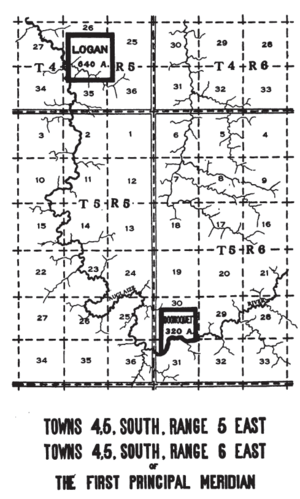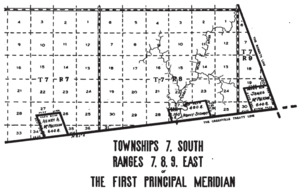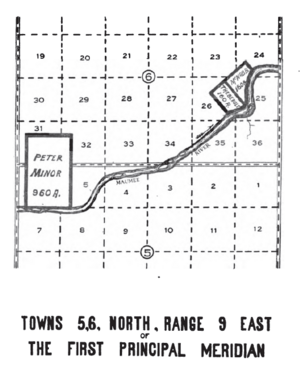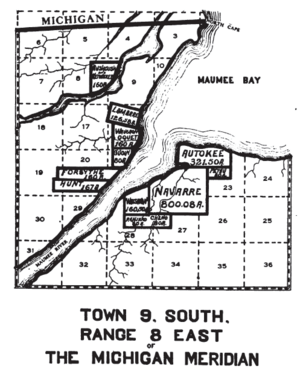Indian Land Grants facts for kids

Indian Land Grants were special areas of land given to different Native American tribes. These lands were given either through official agreements called treaties or by decisions made by the United States Congress. This happened in the 1800s, mostly in northwestern Ohio. These grants were important because they recognized the rights of Native American leaders and families to specific lands.
Contents
Land Grants Near the St. Mary's River
Many land grants were located along the St. Mary's River. These grants were often given to important Native American leaders or people who had helped the United States.
Jean Baptiste Richardville's Land
Jean Baptiste Richardville was a main chief of the Miami tribe. He received land through the Treaty of St. Mary's in 1818. In Ohio, he was given two sections of land (about 1,280 acres). This land was near a creek where the road from St. Mary's to Fort Wayne crossed. It was partly in Van Wert County, Ohio.
Peter Labadie's Land
Peter Labadie also received 640 acres of land from the Treaty of St. Mary's. His land was along the St. Mary's River in Van Wert County, Ohio and Mercer County, Ohio.
Charley's Land Grant
A Miami chief named Charley was granted 640 acres of land. This land was on the west side of the St. Mary's River in Mercer County, Ohio. This grant was also part of the Treaty of St. Mary's.
Black Loon and Crescent's Land
Two people, Black Loon (also called Macultamunqua) and Crescent (also called Wemetche), each received 640 acres of land. Black Loon's land was on the north side of the St. Mary's River, and Crescent's was on the opposite side. This area is known as Black Loon Crescent.
Anthony Shane's Grants
Anthony Shane was part European and part Ottawa. He lived by the St. Mary's River before the War of 1812. In 1815, Congress gave him 320 acres for his help during the war. Later, the Treaty of Fort Meigs gave him another 640 acres on the other side of the river. This land is in Dublin Township, Mercer County, Ohio.
Louis Godfroy's Land
The Treaty of St. Mary's also gave Louis Godfroy a large area of land. He received six sections, which is about 3,840 acres. This land was upstream from Anthony Shane's land on the St. Mary's River in Mercer County, Ohio.
Land Grants on the Auglaize River
Other important land grants were located along the Auglaize River.
Captain Logan's Children's Land
Captain Logan was a Shawnee chief who helped the Americans during the War of 1812. After he died, the Treaty of Fort Meigs gave his children 640 acres of land. This land was on the east side of the Auglaize River in Auglaize County, Ohio.
Francis Duchouquet's Land
Francis Duchouquet was a Shawnee chief. In 1836, Congress approved a grant of 320 acres for him. This land was in Auglaize County, Ohio. The area where this land was located, Duchouquet Township, is named after him.
Land Grants Near the Greenville Treaty Line
Some land grants were made along the Greenville Treaty Line. This line was an important boundary set in an earlier treaty.
James McPherson's Land
James McPherson was a white man who had lived with Native Americans since he was young. The Treaty of Fort Meigs gave him 640 acres of land. He chose land where a survey line met the Greenville Treaty Line. Later, the Treaty of Lewistown in 1831 gave him an additional 320 acres next to his first grant.
Nancy Stewart's Land
Nancy Stewart was the daughter of a famous chief named Blue Jacket. The Treaty of Fort Meigs gave her 640 acres. Most of this land was on the east side of the Great Miami River, next to the Greenville Treaty Line.
Henry H. McPherson's Land
Henry McPherson was adopted by the Seneca and Shawnee tribes. The Treaty of Wapakoneta gave him 320 acres of land. This was in addition to 320 acres he had already received from the chiefs. His land was in Shelby County, Ohio.
Land Grants on the Sandusky River
| Upper Sandusky | Middle Sandusky | Lower Sandusky |
|---|---|---|
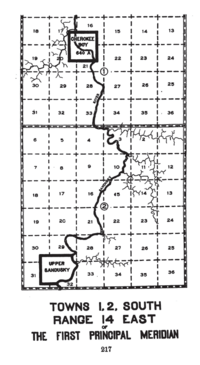 |
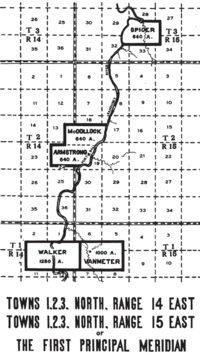 |
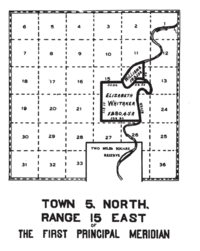 |
Many land grants were also made along the Sandusky River.
Horonu's Land
Horonu, also known as The Cherokee Boy, was a Wyandot chief. The Treaty of Fort Meigs in 1817 gave him 640 acres on the Sandusky River. This land was in Wyandot County, Ohio.
John Vanmeter's Land
John Vanmeter was married to a Seneca woman and lived near the Sandusky River. He, his wife, and her three brothers received 1,000 acres around his home from the Treaty of Fort Meigs.
John R. Walker's Land
John R. Walker was a Wyandot man who was hurt fighting for the United States in the War of 1812. The Treaty of Fort Meigs gave him and his mother, Catherine Walker, 640 acres each. Their land was next to John Vanmeter's.
Robert Armstrong's Land
Robert Armstrong was a white man married to a Wyandot woman. The Treaty of Fort Meigs gave him 640 acres on the west side of the Sandusky River.
William McCollock's Children's Land
The children of William McCollock, who was part Wyandot, received 640 acres. Their father was killed in the War of 1812. Their land was next to Robert Armstrong's grant.
William Spicer's Land
William Spicer was a white man married to a Seneca woman. The Treaty of Fort Meigs gave him 640 acres on the east side of the Sandusky River, around his home.
Elizabeth Whitaker's Land
Elizabeth Whitaker was a white woman who had been captured by the Wyandots but chose to stay with them. The Treaty of Fort Meigs gave her 1,280 acres on the west side of the Sandusky River, downstream from Croghansville. This land is in Sandusky County, Ohio.
Sarah Williams' Land
Sarah Williams was a white widow of a man who was half Wyandot. The Treaty of Fort Meigs gave her and her two children 160 acres. This land was on the east side of the Sandusky River in Sandusky County, Ohio.
Land Grants on the Maumee River
Some land grants were also made along the Maumee River.
Peter Minor's Land
Peter Minor, also known as Yellow Hair, was an adopted son of a chief. The Treaty of Fort Meigs gave him 640 acres on the north side of the Maumee River. Later, in 1831, the Treaty with the Ottawa gave his children an additional 320 acres. This combined 960 acres is in Lucas County, Ohio.
Hiram Thebault and William McNabb's Land
In 1831, the Treaty with the Ottawa gave Hiram Thebault, who was half Ottawa, 160 acres around his home on the Maumee River. William McNabb, also half Ottawa, received an adjacent 160-acre tract.
Maumee Bay Land Grants
The Treaty with the Ottawa in 1833 made several grants around Maumee Bay, where the Maumee River flows into Lake Erie.
On the south side of the river, a large area of 1,520 acres was set aside.
- Autokee, a chief, received 320 acres, which included Presque Isle.
- The Navarre family (Jacques, Robert, Peter, Antoine, Francis, and Alexis) received 800 acres.
- Wasayon received 160 acres, including his father's home.
- Petau received 80 acres around her cabin.
- Cheno, a chief, received 80 acres.
- Joseph La Cavalier Rajnard also received 80 acres.
On the north side of the river, several grants were made:
- Wausaonoquet, a chief, received 160 acres where Pike Creek enters the bay.
- Leon Guoin received 80 acres next to Wausaonoquet's land.
- Aushcush and Ketuckkee received 160 acres on the north side of the Ottawa Creek, where Aushcush lived.
- Robert A. Forsythe and John E. Hunt each received two 160-acre tracts.
Finally, Andre Lamarre was granted 126.58 acres on the north side of Maumee Bay by Congress in 1812. All these Maumee Bay grants were located in Lucas County, Ohio.



